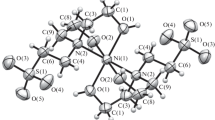Summary
Investigations were carried out on the isomerization and base hydrolysis ofcis andtrans forms of dithiosulphatobis-(ethylenediamine)cobalt(III) ions. Thecis form isomerizes to thetrans form in neutral aqueous medium, rates being 1.15, 2.30 and 4.0×10−5s−1, respectively at 42, 50 and 58 °C. Thetrans complex isomerizes to thecis form in basic solution only, the rate varying with pH in a sigmoid pattern. In presence of OH−, an acid-base equilibrium of the complex ion sets in, but only the basic form takes part in the isomerization reaction. Hydrolysis of thecis isomer proceeds through a base-dependent path only, but that of thetrans isomer proceeds both through base-dependent and base-independent paths. The mechanisms are associative in nature. Thetrans form reacts faster thancis in all cases.
Similar content being viewed by others
References
R. G. Pearson, R. E. Meeker and F. Basolo,J. Am. Chem. Soc., 78, 709 (1956); M. L. Tobe,Adv. Chem. Ser., 49, 7 (1965); B. Bosnich, C. K. Ingold and M. L. Tobe,J. Chem. Soc., 4074 (1965).
V. F. Seel and D. Meyer,Z. Anorg. Chem., 408, 283 (1974).
A. W. Chester,Inorg. Chem., 8, 1584 (1969);9, 1746 (1970); T. P. Dasgupta and M. L. Tobe,Inorg. Chem., 11, 1011 (1972).
D. R. Stranks and J. K, Yandell,Inorg. Chem, 9, 751 (1970).
P. Ray and S. N. Maulik,J. Indian Chem. Soc., 10, 655 (1933).
J. C. Duff,J. Chem. Soc., 453 (1922).
P. M. Brown and G. M. Harris,Inorg. Chem., 7, 1872 (1968).
R. G. Bates,Determination of pH, Wiley, New York (1954), p. 160;
A. I. Vogel,A Text Book of Inorganic Analysis, 4th Edit., Longmann Group Ltd. (1978).
B. Chakravarty and A. K. Sil,Inorg. Chim Acta, 24, 105 (1977).
S. Glasstone, K. Laidler and H. Eyring.The Theory of Rate Processes, McGraw Hill Book Co., New York (1941), p. 189.
M. E. Farago, B. A. Page and C. F. V. Mason,Inorg. Chem., 8, 2270 (1969).
D. Banerjea and T. P. Dasgupta,J. Inorg. Nucl. Chem., 27, 2617 (1965).
J. Burgess,Specialist Periodical Report, Inorg. Rech. Mechns. Part III, The Chemical Society, London, p. 231.
S. C. Chan and M. L. Tobe,J. Chem. Soc., 4531 (1962).
F. Basolo and R. G. Pearson,Mechanisms of Inorganic Reactions, Wiley Eastern, New Delhi (1973), p. 172.
W. Kruse and H. Taube,J. Am. Chem. Soc., 83, 1280 (1961).
D. F. Martin and M. L. Tobe,J. Chem. Soc., 1388 (1962).
M. L. Tobe, inStudies on Chemical Structure and Reactivity, Ed. J. H. Ridd, Mathuen, London (1966).
N. Serpone and D. G. Bickley, inInorganic Reaction Mechanisms. Part. II (Progress in Inorganic Chemistry, Vol. 17) Ed. J. O. Edwards, Interscience, New York (1972), p. 505.
D. M. Goodall and M. J. Hardy,J. Chem. Soc., Chem. Comm., 919 (1975).
Author information
Authors and Affiliations
Rights and permissions
About this article
Cite this article
Chakravarty, B., Kumar Das, P. Kinetics and mechanisms of the reactions of thiosulphato-amine complexes of cobalt(III). Part I. Isomerization and base hydrolysis ofcis andtrans isomers of dithiosulphatobis(ethylenediamine) cobalt(III) ion in aqueous solution. Transition Met Chem 7, 340–346 (1982). https://doi.org/10.1007/BF00618347
Received:
Issue Date:
DOI: https://doi.org/10.1007/BF00618347




